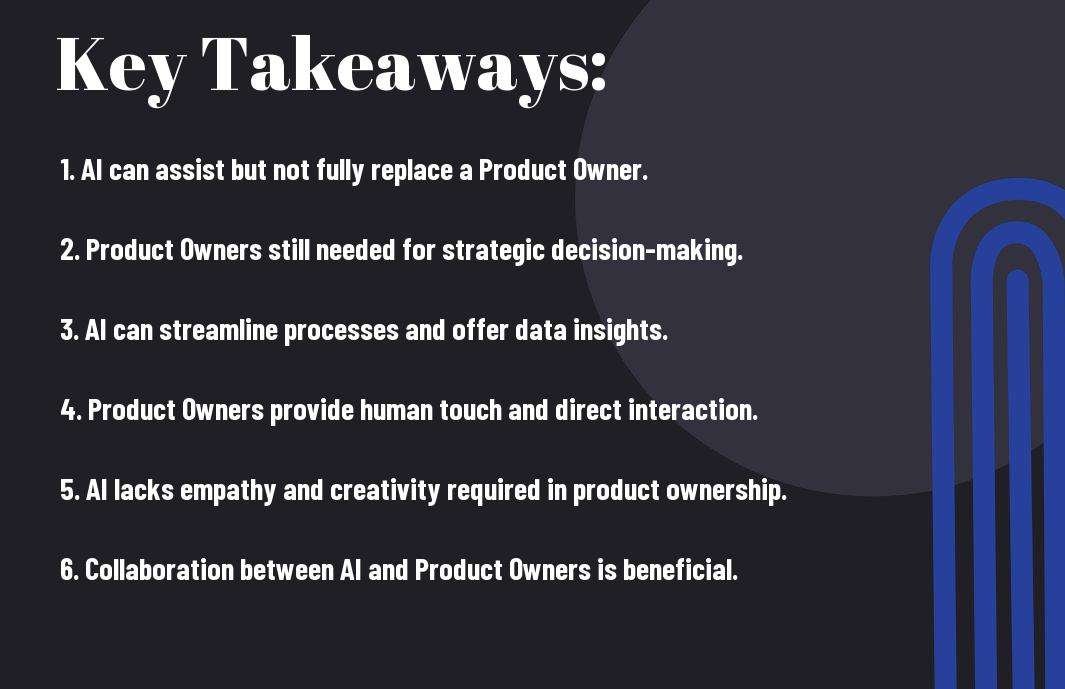It’s a question that’s been on the minds of business leaders and tech enthusiasts alike – can AI truly take over the responsibilities of a product owner in executive leadership roles? In this informative piece, we will research into the advancements in artificial intelligence and the impact they could have on the traditional role of a product owner. Explore the possibilities and challenges that come with this potential disruption in the tech industry.
Key Takeaways:
- AI cannot fully replace the role of a Product Owner: While AI can support and enhance decision-making processes, a human Product Owner brings critical thinking, creativity, and emotional intelligence to the role that cannot be replicated by AI.
- Product Owners play a strategic role in Executive Leadership: Product Owners translate business goals into actionable plans, prioritize features, and collaborate with stakeholders. Their strategic insights and ability to align product goals with organizational objectives are crucial in executive leadership.
- A combined approach is most effective: AI can assist Product Owners by providing valuable data, insights, and automation, allowing them to focus on higher-level tasks. Combining AI capabilities with human skills can lead to more effective and innovative product management.

The Role of a Product Owner in Executive Leadership
Defining the Product Owner’s Responsibilities
Product Owners play a crucial role in executive leadership by bridging the gap between the business stakeholders and the development team. They are responsible for defining and prioritizing the product roadmap, ensuring that the development team is aligned with the business goals, and ultimately delivering a successful product to the market. Product Owners also act as the voice of the customer, advocating for their needs and ensuring that the product meets user expectations.
The Importance of Human Judgment in Decision-Making
Role Although AI technology has advanced significantly in recent years, there are still certain aspects of decision-making that require human judgment. As a Product Owner in executive leadership, your ability to analyze complex situations, understand the nuances of user feedback, and navigate ambiguous requirements is invaluable. While AI can assist in data analysis and provide insights, it cannot fully replace the human touch needed to make strategic decisions that align with business objectives.
To lead effectively as a Product Owner, you must leverage your cognitive abilities, emotional intelligence, and critical thinking skills to drive the product’s success. Your capacity to empathize with users, communicate effectively with stakeholders, and adapt to changing market dynamics are vital components of your role in executive leadership. By incorporating your human judgment into decision-making processes, you can steer the product towards sustainable growth and innovation.

Can AI Replace Human Judgment?
While artificial intelligence (AI) has made significant advancements in recent years, the question remains: can it truly replace human judgment, especially in the complex role of a Product Owner in executive leadership?
The Capabilities of Artificial Intelligence
The capabilities of artificial intelligence are vast and impressive. AI can process and analyze massive amounts of data at a speed and scale that is impossible for a human to achieve. It can identify patterns, trends, and insights that may elude human cognition, helping leaders make data-driven decisions with a higher degree of accuracy and efficiency.
The Limitations of AI in Complex Decision-Making
To truly understand the limitations of AI in complex decision-making, you need to recognize that AI operates based on algorithms and historical data. While AI can predict outcomes based on patterns from the past, it may struggle in situations where there are no clear historical data points to rely on. This is especially true in dynamic and unpredictable environments where novel solutions and creativity are crucial.
This limitation means that AI may not be able to fully replace the nuanced decision-making abilities of a human Product Owner who can adapt to new information, consider various stakeholders’ perspectives, and navigate ambiguous situations with empathy and strategic insight.
AI’s Potential in Data Analysis and Insights
The Role of Data in Product Development
One of the key components of successful product development is data analysis. By utilizing data, product owners can gain valuable insights into customer behavior, market trends, and product performance. This information is crucial for making informed decisions that drive the product forward. Data helps product owners identify areas for improvement, opportunities for growth, and potential challenges that may arise.
AI’s Ability to Process and Analyze Large Data Sets
Potential for AI to process and analyze large data sets is immense. With its advanced algorithms and machine learning capabilities, AI can quickly process vast amounts of data to uncover patterns, trends, and actionable insights. This accelerates the data analysis process, enabling product owners to make data-driven decisions more efficiently. AI can handle complex data sets much faster and with higher accuracy than manual analysis, leading to more informed decision-making in product development.
Data is the lifeblood of product development, and the ability to extract meaningful insights from it is critical for success. AI’s capacity to process huge volumes of data in real-time and identify significant patterns and trends can revolutionize how product owners approach decision-making. By leveraging AI for data analysis, product owners can stay ahead of the curve, make informed decisions, and drive innovation in their products.
The Human Touch in Stakeholder Management
Building Relationships with Stakeholders
Your role as a Product Owner goes beyond just managing tasks and responsibilities; it involves building strong relationships with stakeholders involved in the project. Effective communication and active listening are crucial skills when dealing with stakeholders, as understanding their needs and concerns can greatly impact the success of the project. By establishing trust and rapport with stakeholders, you can ensure smooth collaboration and alignment towards common goals.
The Importance of Empathy and Emotional Intelligence
The success of a project often hinges on your ability to empathize with stakeholders and demonstrate emotional intelligence in your interactions. Empathy allows you to understand the perspectives and emotions of others, fostering trust and cooperation in working relationships. Emotional intelligence helps you navigate challenging situations, resolve conflicts, and inspire confidence in your leadership.
Empathy and emotional intelligence are crucial qualities that can set you apart as a Product Owner. They enable you to connect on a deeper level with stakeholders, anticipate their needs, and address concerns proactively. By emphasizing these traits in your leadership, you can build a solid foundation for successful project outcomes and nurture long-lasting relationships with stakeholders.
AI’s Ability to Automate Repetitive Tasks
Not only can AI help in automating repetitive tasks, but it can also significantly improve the efficiency of product development processes. By leveraging AI technologies, organizations can streamline their operations and enhance productivity.
Streamlining Product Development Processes
Processes are crucial in product development, and AI can play a key role in optimizing them. AI algorithms can analyze vast amounts of data to identify patterns, predict outcomes, and even suggest improvements. This automation of tasks such as data analysis, project monitoring, and performance evaluations can dramatically reduce errors and speed up decision-making processes.
Freeing Up Human Resources for Strategic Thinking
On the other hand, AI’s ability to automate repetitive tasks
can free up human resources for more strategic thinking. Instead of spending time on mundane and routine activities, employees can focus on higher-value tasks such as innovation, creativity, and problem-solving. This shift can lead to a more agile and forward-thinking organization that is better equipped to navigate the complexities of the modern business landscape.
The Challenges of Implementing AI in Executive Leadership
Integrating AI into Existing Organizational Structures
To successfully implement AI in executive leadership, you must consider how to integrate it into your existing organizational structures. This process can be challenging as it requires aligning AI technology with your company’s goals, workflows, and culture. You may face resistance from employees who fear job displacement or lack the necessary skills to work alongside AI tools. Overcoming these hurdles will require clear communication, training programs, and reassurance that AI is meant to enhance, not replace, human roles.
Addressing Concerns about Job Displacement and Ethics
With the integration of AI into executive leadership comes concerns about job displacement and ethics. People may worry that AI will take away their jobs or make biased decisions that could harm individuals or communities. It is crucial to address these concerns proactively by implementing transparent processes, accountability measures, and continuous monitoring of AI systems. Establishing clear ethical guidelines and protocols will help build trust among employees and stakeholders, ensuring that AI is used responsibly and equitably.
This necessitates a deep examine ethical considerations and a commitment to preserving jobs while utilizing AI for enhanced decision-making. Emphasizing ongoing professional development and upskilling opportunities can help your team adapt to working alongside AI, fostering a more collaborative and innovative organizational culture. By prioritizing ethics and job preservation, you can harness the full potential of AI technology in executive leadership while mitigating potential risks.
Final Words
Following this analysis of whether AI can replace the role of a Product Owner in executive leadership, it is evident that while AI can streamline processes and offer valuable insights, there are key aspects of leadership that require human intuition, empathy, and adaptability. As outlined in the article Can AI Replace Product Managers?, the intricate decision-making, strategic thinking, and vision setting still necessitate human intervention to ensure success.
While AI can enhance the performance and efficiency of a Product Owner, the core responsibilities of inspiring and motivating a team, navigating complex relationships, and making moral judgments remain firmly within the purview of human leaders. Therefore, while AI can support and augment the role of a Product Owner, it is unlikely that it can completely replace the indispensable qualities that human leaders bring to executive leadership.
Q: Can AI completely replace the role of a Product Owner in executive leadership?
A: While AI can automate certain tasks and assist in decision-making processes, it is unlikely that it can fully replace the role of a Product Owner. The human element of understanding business goals, stakeholder needs, and building relationships is crucial for successful product development.
Q: How can AI support the role of a Product Owner in executive leadership?
A: AI can support Product Owners by providing data-driven insights, automating repetitive tasks, and facilitating better decision-making processes. This can help Product Owners focus on strategic planning, stakeholder engagement, and driving innovation within their organizations.
What are some limitations of using AI to replace the role of a Product Owner in executive leadership?
A: Some limitations of using AI to replace the role of a Product Owner include the inability to fully understand human emotions, complex relationships, and nuanced business contexts. Product Owners also bring creativity, empathy, and strategic thinking that are difficult for AI to replicate.







